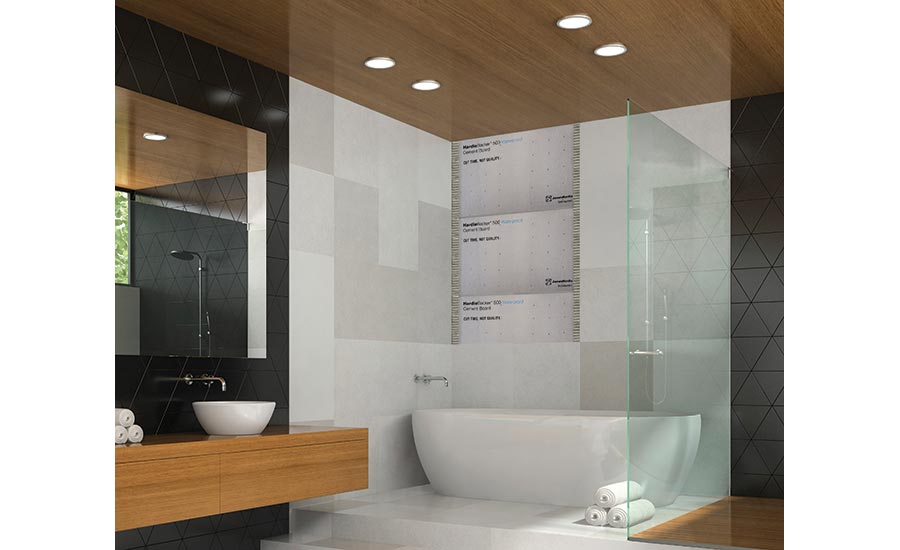Installation Issues & Solutions
The evolution of cement backer boards

It is recommended to work with cement rigid backer boards because of their high shear bond strength, giving installers more leeway with thinset application.
Photos courtesy of James Hardie



Like most innovations and inventions, rigid cement backer boards were born out of necessity. Historically, builders would use drywall or wood to support tile installations because these two materials proved to work well at first, but they inevitably failed over time. Continuous exposure to water can be lethal for drywall and detrimental to wood, yet in certain areas of the home like kitchens and bathrooms, water contact is unavoidable.
Drywall can fail in wet areas because it is made of gypsum, a soft sulfate mineral that loses strength when it absorbs water. Over time, the drywall’s integrity is compromised and the strength of a tile-install base is severely weakened. Furthermore, the paper face of drywall is an organic substance and a viable food source for mold and mildew. Wood’s structural integrity is vulnerable to water as well. Exposure to water over time can drive up the moisture content in the wood to its fiber saturation point, potentially leading to swelling, shrinking and decay, which can cause structural damage.
To act as a base for tile installs and to avoid placing wood or drywall directly onto floors or walls, builders would use a technique called mud-set or “mudding.” This method is a sound practice, but it is a time-consuming, laborious and challenging process for most builders.
In response to builders’ needs for a reliable solution, James Hardie engineered HardieBacker® Cement Board, a labor- and time-efficient alternative to mud-set, serving as a sturdy, water-resistant base for tile installs.
Alleviating tile installation issues with cement backer board
Common tile installation issues can wreak havoc, not only on the structural integrity of a jobsite, but also the overall aesthetic and quality of the work. The cracking of grout lines, the popping off of loose tiles, tile buckling and mold in the grout lines are all common yet avoidable tile installation issues.
Choosing a cement backer board that has a high flexural and compressive strength is important to avoid cracking and create a solid foundation for your tile job. HardieBacker® Cement Board resists bending and fractures to provide a stiff and sturdy base from the day the tile is installed to the day the tile is removed. And while backer boards are not rated as a structural member, their compressive and flexural strength can help mask or make up for deficiencies in subfloor construction.
Another important component to consider when installing tile is shear bond strength -- that is, the measure of tile adhesion. It is recommended to work with cement rigid backer boards because of their high shear bond strength, giving installers more leeway with thinset application. In other words, if the thinset is not perfectly mixed or does not have total coverage under the tile, there is a better chance of maintaining a perfect look than with bases that provide lower shear bond rates.
Cement backer boards are comprised of stable Portland cement, aggregates and reinforcements that are substantially unaffected by prolonged exposure to moisture. Cement backer boards are designed for wet areas and have water-resistant properties to help protect tile installations from moisture penetration. HardieBacker® Cement Board is also manufactured with mold-resistant properties to protect the board. That is, if mold does grow through tile grout lines, the backer board should remain mold-free, so simple treatment to kill mold in the affected area can be executed without too much concern that the mold could spread through the cement board itself.
All of this was considered when James Hardie developed its latest backer board innovation, HardieBacker® Cement Board with HydroDefense™ Technology, the first and only waterproof cement backer board on the market. Passing the ANSI A118.10 standard for waterproofness, the board helps protect tile installations and wall cavities from moisture penetration, reducing the need to spend extra time applying waterproof coating across the entire surface area of your wall project. Unlike other cement backer boards, the composition of the substrate in the board has been altered for waterproofness, a patent-pending technology that is exclusive to James Hardie. HardieBacker® Cement Board with HydroDefense™ Technology is rolling out to select markets in spring 2019.
Looking for a reprint of this article?
From high-res PDFs to custom plaques, order your copy today!











